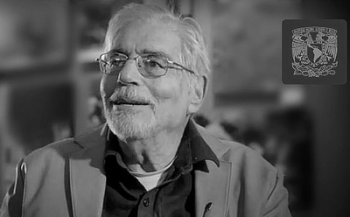Cinna Lomnitz (1925 - 2016)
 On July 7, 2016, Cinna Lomnitz died at the age of 91, in Mexico City. He was an internationally famous seismologist having a German-Chilean-Mexican multi-nationality. A Geosciences era ends with him. His life was unusually plenty of experiences, and its complete narration is impossible. He always felt connected to Germany, his birth country, keeping a very close contact with geo-scientists from Institutes in Karlsruhe, Jena, Kiel and Potsdam, to name only a few of them. Over the last 10 to 15 years I have been Cinna's closest contact in Germany, so I feel committed to write this obituary.
On July 7, 2016, Cinna Lomnitz died at the age of 91, in Mexico City. He was an internationally famous seismologist having a German-Chilean-Mexican multi-nationality. A Geosciences era ends with him. His life was unusually plenty of experiences, and its complete narration is impossible. He always felt connected to Germany, his birth country, keeping a very close contact with geo-scientists from Institutes in Karlsruhe, Jena, Kiel and Potsdam, to name only a few of them. Over the last 10 to 15 years I have been Cinna's closest contact in Germany, so I feel committed to write this obituary.
Cinna Lomnitz was born in Cologne, and spent his childhood and youth in Belgium and Chile. He obtained his engineer degree in 1948 at the "Facultad de Física y Matemáticas" from Chile's University. Later, he studied at Harvard University with Karl von Terzaghi, where he obtained a Master degree in Soil Mechanics. Another important moment of his life was his stay at CalTech, in Berkeley, where he was fortunate to make his PhD thesis entitled: "Creep measurements in igneous rocks with some applications to aftershock theory", under the leadership of the famous scientists Hugo Benioff and Beno Gutenberg. In Berkeley, he attended Anderson's courses, Nobel Prize winner and discoverer of Positrons, and also Feynman's. In 1955, Cinna was the first Latin American to obtain a PhD in Geophysics. In his thesis he observed a logarithmic time dependence of the igneous rock deformation, reformulated in 1958 by Sir Harold Jeffreys and known in the literature as Lomnitz law.
Being a student of Benioff, Cinna was invited to Israel to set up short-period seismic sensors while training Ari Ben-Menahem, who became a leading seismologist in his country. Cinna worked as Charles Richter's assistant before returning to Chile's University, where he was the director of a Geophysics Institute created for him. In 1959, during the International Geophysical Year, he participated in a research expedition of the Earth's crust along the coast of Chile on the research vessel Yema, led by Maurice Ewing. In 1964 he took the leadership of the seismic network of the University of California (Berkeley). At this time the theory of tectonic plates emerges: Cinna accepted, incorporated and applied the theory in his lessons and lectures (he was one of the first geophysicists to do so). Later in his scientific career he climbed positions at the Universities of California (Berkeley), Kyoto, Kiel and Bahia (Brazil) and worked from 1968 up to the end of his life at the Geophysics Institute of the University of Mexico (UNAM).
Cinna Lomnitz founded and led several national and local seismic networks while working at UNAM. As an expert in soil mechanics he was aware of seismic hazards in the Valley of Mexico, such as the catastrophic effects of 19 September, 1985, earthquake. Since then, he concentrated his research on the possible causes of this disaster. He contributed with building regulations and investigated, theoretically and practically, the wave movements on soft soils, contacting foreign specialists and researchers from the Instituto de Física (UNAM). His work was distinguished for unconventional and innovative ideas. In recent years, he worked on a new theory on the formation of tsunamis, that he applied, after the 2011 Tohoku earthquake, to analyse the nuclear disaster in Fukushima. Cinna produced more than 100 scientific articles and 4 books, including one on plate tectonics. He was also a member of several national and international scientific organizations, and during a certain time a member of the DGG.
He was Editor in Chief of Geofísica Internacional and scientific editor of Nexos. He was recognized with the National Award for Arts and Science in 1995, and with the National University Award in 1997. In 2002, he was appointed as a Special Professor Emeritus, a special honour in Mexico, not granted automatically with the retirement. More recently, in 2015, due to his efforts for the safety from earthquakes in Mexico, he received from the local government the "Angel of the City" title.
Finally, some personal words. During our 17 years of friendship, Cinna Lomnitz always stood by me in difficult personal situations with advice and parental support. Those who were lucky enough to know him will never forget his essentially warm character, which will be surely missed in the future. His extraordinary and broad culture was always present in many aspects which he was able to transmit convincingly. I remember him with gratitude and respect. Rest in peace.
Peter Malischewsky
Friedrich-Schiller University Jena, Germany
